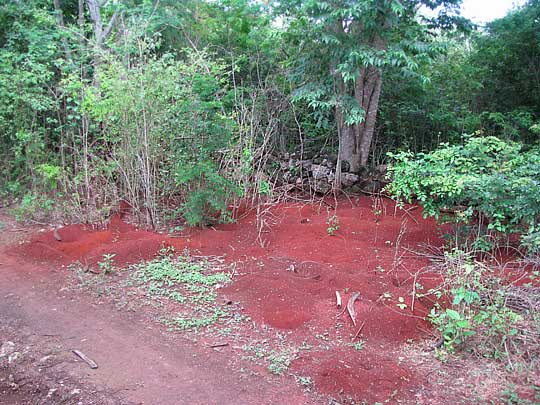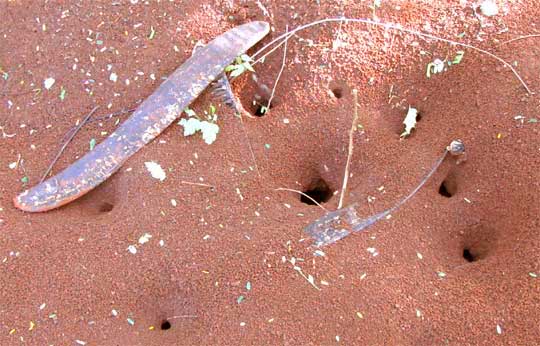Excerpts from Jim Conrad's
Naturalist Newsletter
from the December 19, 2004 Newsletter written at Hacienda Komchen de Los Pájaros
just outside Dzemul, Yucatán, MÉXICO
LEAFCUTTER ANTS






The other night I was sitting at the edge of one of the fishponds when something small and pale showed up moving along the pond's edge. When I got on my hands and knees I saw that the pale thing was a small flower being carried by a somewhat larger, black ant. Moreover, behind this ant and flower came another ant and flower, and behind that another, and another, and another...
I knew we had leafcutter ants here because each night all the new leaves of our Tropical Almond trees were being removed, just the way leafcutter ants do. To save the trees Ana María had erected barriers around each tree's trunk, atop which she positioned rags soaked in used motor-oil.
Leafcutter ants normally work at night and they can defoliate an entire tree the size of a mature apple tree in one attack. An ant goes to a leaf and with its mandibles cuts out a leaf section -- or nips off a flower or other object of appropriate size -- then carries it back to its nest. At the nest the carried- back material is stored in subterranean chambers, where a special kind of fungus is allowed to grow on it. Ultimately the ants eat that fungus. The ants don't eat the material they carry back, just the fungus.
When I worked as a naturalist in a "jungle lodge" in Belize I got to know leafcutter ants very well. I'd take tourists on flashlight-carrying night-walks through the forest, and usually the highlight of each walk was watching the long lines of leafcutter ants carrying their booty home. It was easy to follow the ants to their nests, and sometimes the nest's excavated dirt would occupy a surface area the size of a car.
My main experience with leafcutter ants in Belize was with a leafy crop of collards-like Bok Choy I grew there. With enormous effort I cleared away the weeds, pulled up ridges, sowed, and assiduously watered my Bok Choy until I got a crop pretty enough to appear on a seed-catalogue's cover. But, then, just as the plants were getting large enough to be eaten, one night a tourist came asking what kind of ants those were carrying little green umbrellas from the direction of my garden. The next morning there wasn't a single leaf of Bok Choy remaining.
I'm not really sure how to garden in a world with leafcutter ants. My approach now is just to plant a lot of stuff and hope the ants don't like some of it. They clearly have their favorite foods, and I'm banking on their favorites not including the squash, peppers, tomatoes and herbs I've planted.
You can learn a lot more about leafcutter ants, see pictures and even view a four-minute movie about them at www.blueboard.com/leafcutters/.
from the November 3, 2008 Newsletter written in Yokdzonot and issued from a ciber in Pisté, Yucatán, MÉXICO:
LEAFCUTTER-ANT CITY
Frequently I've discussed leafcutter ants but I don't think I've commented on their large mound complexes, as below:

All that red dirt, about 20 feet across, has been excavated from ant tunnels below, so you can imagine the extent of the tunnels and the size of the chambers where they store their leaf tatters, on which fungus lives, which the ants eat. The complex in the picture occurs along a trail I frequently travel. Many entry tunnels occur throughout the complex, as shown below:

The faded, 18-inch long (45 cm) legume at the top, left is from the big Royal Poinciana tree above it.
During the day sometimes you see one or two leafcutter ants wandering atop the complex, sometimes carrying leaf segments above themselves, but leafcutter ants work mainly at night. Back when I led night-walk nature hikes in Belize the trail passed by a complex similar to this. Tourists were often more fascinated by the long ant-trails, which they followed for hundreds of feet with flashlights, more than anything else on the walk.